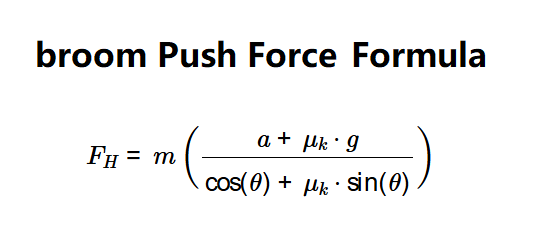 Home
Home
 Back
Back

Definition: This calculator determines the horizontal force (\( F_H \)) required to push a broom, based on its acceleration (\( a \)), mass (\( m \)), friction coefficient (\( \mu_k \)), broom angle (\( \theta \)), and acceleration due to gravity (\( g \)).
Purpose: It assists in understanding the force needed to move a broom across a surface, accounting for friction and the angle of the broom handle.
The calculator uses the relationship:
Where:
Explanation: Enter the acceleration, mass, friction coefficient, broom angle, and gravity in the chosen units, and the calculator computes the horizontal force. Results use scientific notation (5 decimal places) if the force in newtons is greater than 10000 or less than 0.00001, otherwise 2 decimal places. For the image inputs (\( a = 22 \, \text{m/s}^2 \), \( m = 33 \, \text{kg} \), \( \mu_k = 0.56 \), \( \theta = 55^\circ \), \( g = 9.80665 \, \text{m/s}^2 \)), the calculated force is 878.84 N.
Details: Calculating the horizontal force is crucial for ergonomic design and understanding the effort required to move objects like a broom, considering friction and angular effects, applicable in physics and engineering.
Tips: Enter positive values for acceleration, mass, friction coefficient, and angle, and ensure \( \cos(\theta) + \mu_k \cdot \sin(\theta) \neq 0 \), then click "Calculate." Results show the horizontal force in newtons, pound-force, dynes, and kilogram-force (scientific notation with 5 decimal places if > 10000 or < 0.00001 N, otherwise 2 decimal places).